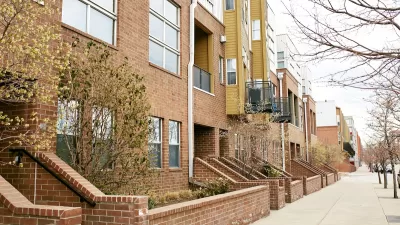In the second part of a four part series on America's pedestrian problem, Tom Vanderbilt evaluates the surprisingly formalized field of pedestrian behavior research, from navigating crowded sidewalks to tripping at the bottom of the stairs.
For someone keen on grasping the nuances of pedestrian behavior, the whole of the United States offers no better destination than New York City. And in the City, Vanderbilt writes, street corners offer some of the best views around:
"Here was a zone of serendipity where people encountered one another beneath the blinking walk man, where they paused to chat before parting, where they formed small convivial islands just as pedestrian flow was surging most strongly... The corner is urban punctuation, a place to pause, essential to the whole civic grammar."
As we discovered last month, social scientists have been analyzing pedestrian behavior since at least the mid-70s, when Jeff Zupan and Boris Pushkarev published Urban Space for Pedestrians. From how crowds pass each other at crosswalks to that awkward game of chicken that pedestrians so often unwittingly play, their research catalogs every minute quirk worth observing. "We were learning by just going out in the field," Zupan says. "If there was something we didn't understand, we went out and took a look."
But the past forty years have taken a considerable share of pedestrian behavior research out of the field, and into the computer. Now, in addition to standing at a crowded escalator and counting how many people opt for the stairs instead, researchers can build immensely complex models to anticipate how people behave under various conditions.
For example, high-density masses of pedestrians (7+ per square meter) begin to behave like a body of fluid, according to engineer John Fruin: "Shock waves can be propagated through the mass, sufficient to... propel them distances of 3 meters or more... People may be literally lifted out of their shoes, and have clothing torn off."
Many aspects of the research have valuable implications for architecture and urban design. Others, like "the way women (in particular) avoid subway grating on the sidewalk," might shed little more than novel insight on the habits we didn't realize we had. Either way, better understanding ourselves as the social, bipedal creatures we are may be an important step in bringing ourselves back to the street.
FULL STORY: Sidewalk Science

Alabama: Trump Terminates Settlements for Black Communities Harmed By Raw Sewage
Trump deemed the landmark civil rights agreement “illegal DEI and environmental justice policy.”

Study: Maui’s Plan to Convert Vacation Rentals to Long-Term Housing Could Cause Nearly $1 Billion Economic Loss
The plan would reduce visitor accommodation by 25% resulting in 1,900 jobs lost.

Planetizen Federal Action Tracker
A weekly monitor of how Trump’s orders and actions are impacting planners and planning in America.

Waymo Gets Permission to Map SF’s Market Street
If allowed to operate on the traffic-restricted street, Waymo’s autonomous taxis would have a leg up over ride-hailing competitors — and counter the city’s efforts to grow bike and pedestrian on the thoroughfare.

Parklet Symposium Highlights the Success of Shared Spaces
Parklets got a boost during the Covid-19 pandemic, when the concept was translated to outdoor dining programs that offered restaurants a lifeline during the shutdown.

Federal Homelessness Agency Places Entire Staff on Leave
The U.S. Interagency Council on Homelessness is the only federal agency dedicated to preventing and ending homelessness.
Urban Design for Planners 1: Software Tools
This six-course series explores essential urban design concepts using open source software and equips planners with the tools they need to participate fully in the urban design process.
Planning for Universal Design
Learn the tools for implementing Universal Design in planning regulations.
Caltrans
Smith Gee Studio
Institute for Housing and Urban Development Studies (IHS)
City of Grandview
Harvard GSD Executive Education
Toledo-Lucas County Plan Commissions
Salt Lake City
NYU Wagner Graduate School of Public Service




























